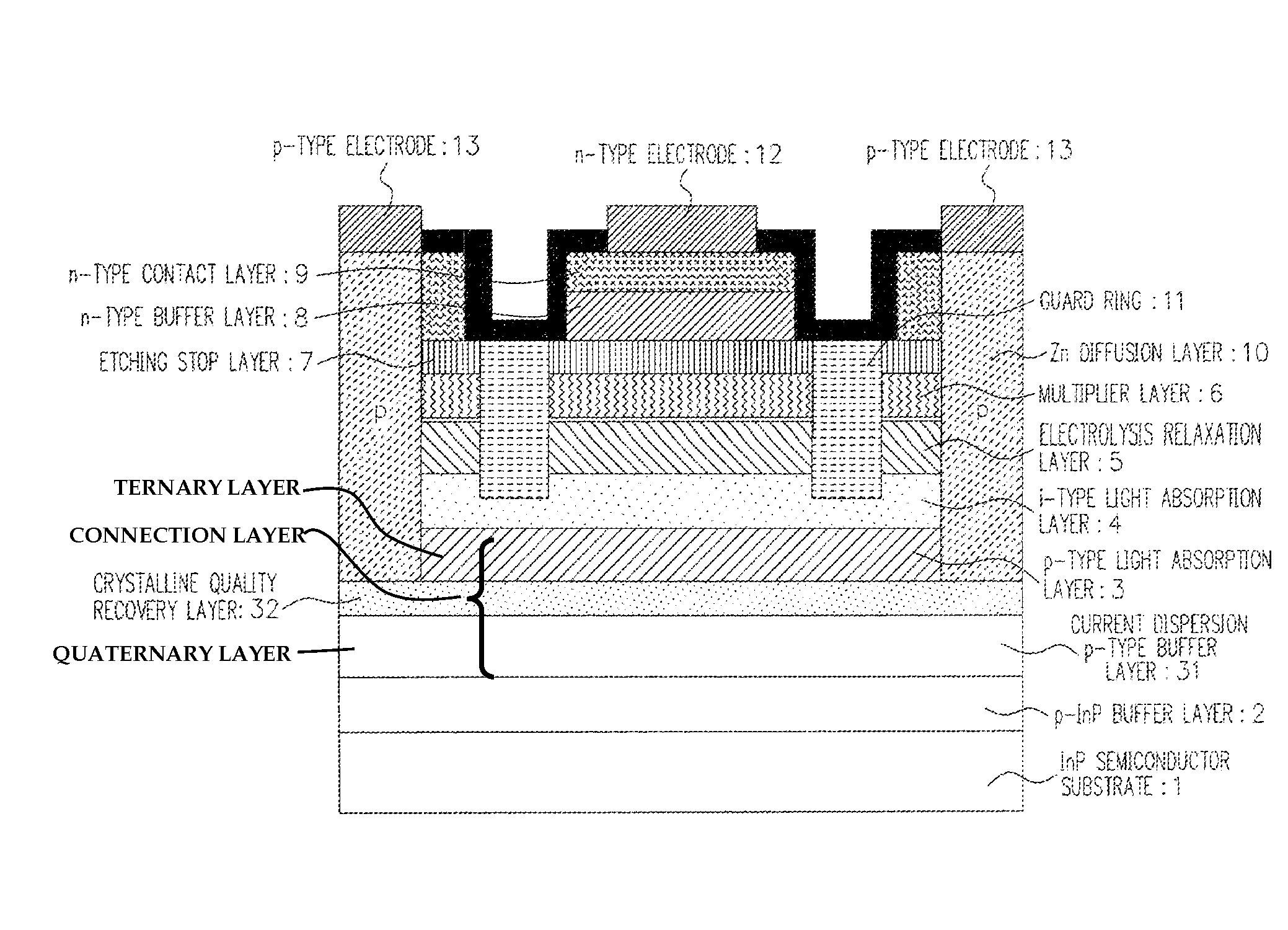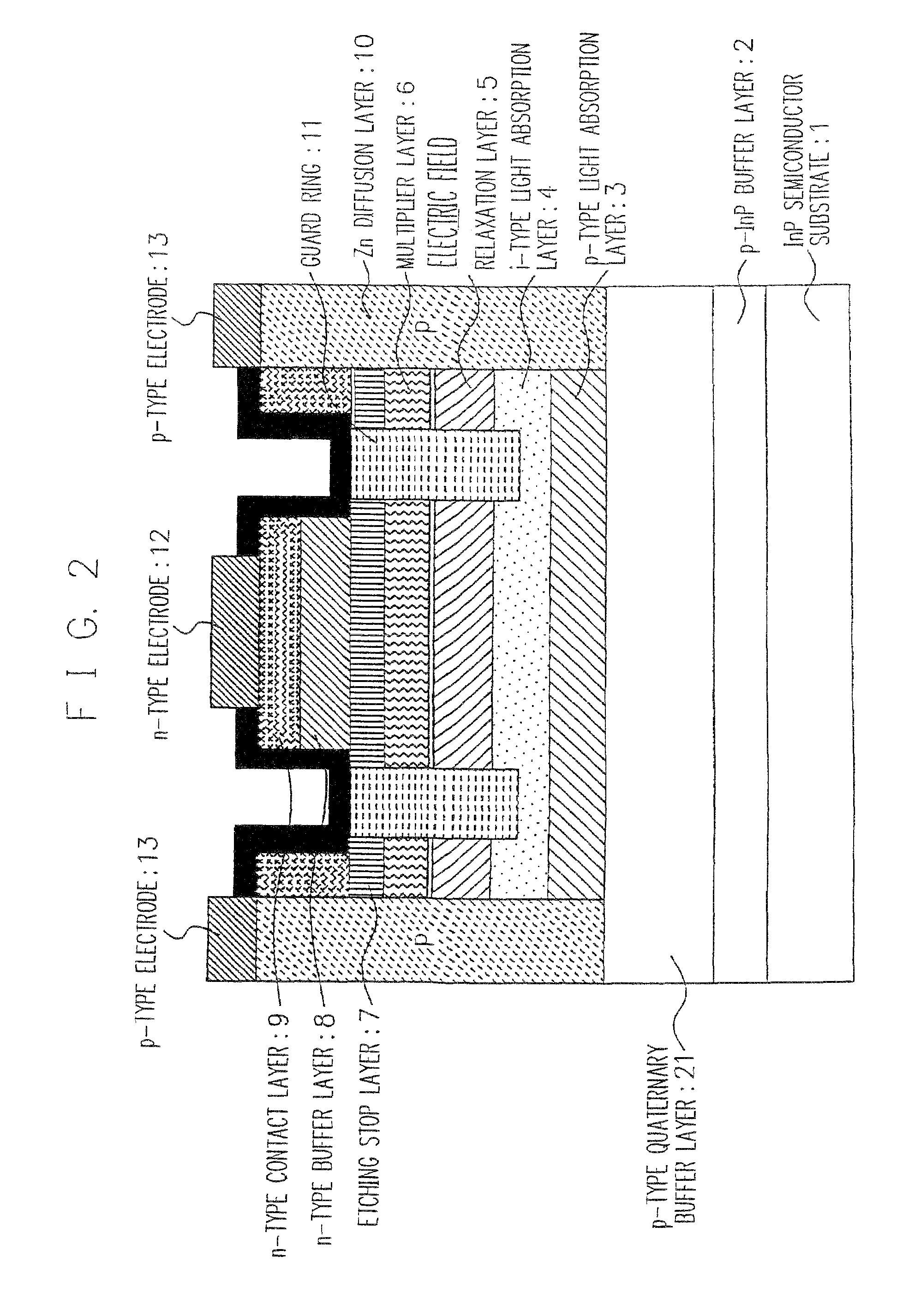Semiconductor light receiving device
a technology of light receiving device and semiconductor, applied in the direction of semiconductor devices, basic electric elements, electrical appliances, etc., can solve the problems of increasing the dark current, the initial characteristics are degraded with certain possibility, and the responsiveness of the device might deteriorate, so as to achieve high speed and high sensitivity characteristics, the effect of high resistance to light inpu
- Summary
- Abstract
- Description
- Claims
- Application Information
AI Technical Summary
Benefits of technology
Problems solved by technology
Method used
Image
Examples
first exemplary embodiment
[0051]Referring first to FIG. 2, the structure of the semiconductor light receiving device of the exemplary embodiment is described.
[0052]As shown in FIG. 2, the semiconductor light receiving device of the exemplary embodiment includes an InP semiconductor substrate (1), a p-InP buffer layer (2), a p-type quaternary buffer layer (21), a p-type light absorption layer (3), an i-type light absorption layer (4), an electric field relaxation layer (5), a multiplier layer (6), an etching stop layer (7), an n-type buffer layer (8), and an n-type contact layer (9).
[0053]In the semiconductor light receiving device of the exemplary including the layer structure shown in FIG. 2, the n-type contact layer (9) and the n-type buffer layer (8) are removed around a light receiving part from the above, until the removal reaches the etching stop layer (7). Ti ions are then implanted to form a guard ring (11). Zn diffusion is then caused in the neighboring area of the guard ring (11), so as to form a Z...
example 1 of first exemplary embodiment
[0077]Referring to FIG. 2, a first example structure of the semiconductor light receiving device of the first exemplary embodiment is now described.
[0078]As shown in FIG. 2, the semiconductor light receiving device of the exemplary embodiment includes the stack structure formed on the InP semiconductor substrate (1). The stack structure includes the p-InP buffer layer (2), the p-type quaternary buffer layer (21), the p-type light absorption layer (3), the i-type light absorption layer (4), the electric field relaxation layer (5), the multiplier layer (6), the etching stop layer (7), the n-type buffer layer (8), and the n-type contact layer (9) stacked in this order. The n-type contact layer (9) and the n-type buffer layer (8) are removed around the light receiving part until the removal reaches the etching stop layer (7). Ti ions are then implanted to form the guard ring (11). After a dielectric film is formed, Zn diffusion is caused in the neighboring area of the guard ring (11) to...
example 2 of first exemplary embodiment
[0080]Referring now to FIG. 4, a second example structure of the semiconductor light receiving device of the first exemplary embodiment is described.
[0081]As shown in FIG. 4, the semiconductor light receiving device of the exemplary embodiment includes the stack structure formed on an InP semiconductor substrate (1). The stack structure includes the p-InP buffer layer (2), the p-type quaternary buffer layer (21), the crystalline quality recovery layer (22), the p-type light absorption layer (3), the i-type light absorption layer (4), the electric field relaxation layer (5), the multiplier layer (6), the etching stop layer (7), the n-type buffer layer (8), and the n-type contact layer (9) stacked in this order. The n-type contact layer (9) and the n-type buffer layer (8) are removed around the light receiving part until the removal reaches the etching stop layer (7). Ti ions are then implanted to form the guard ring (11). After a dielectric film is formed, Zn diffusion is caused in t...
PUM
 Login to View More
Login to View More Abstract
Description
Claims
Application Information
 Login to View More
Login to View More - R&D
- Intellectual Property
- Life Sciences
- Materials
- Tech Scout
- Unparalleled Data Quality
- Higher Quality Content
- 60% Fewer Hallucinations
Browse by: Latest US Patents, China's latest patents, Technical Efficacy Thesaurus, Application Domain, Technology Topic, Popular Technical Reports.
© 2025 PatSnap. All rights reserved.Legal|Privacy policy|Modern Slavery Act Transparency Statement|Sitemap|About US| Contact US: help@patsnap.com



